Abstract
Improving the quality of self-educational activity of trainees using e-learning is currently extremely topical. The performance of independent work of the student is largely dependent on consistency, continuity, and perfection of educational-cognitive activity. High motivation and self-organization of this activity largely depends on self-government and self-control of the learner. In this context, the aim of this work was to develop and justify a method of student self-control by creating an "upside-down" information resources, which visualizes the process of learning and takes into account the characteristics of Z generation. The basis of the proposed method is a topological question- task knowledge tree of the subject area with regulatory tasks or tests. For each question there is a response in the form of concept maps with the necessary educational review, and for the task – an explanation of its decision. With the positive outcome the corresponding elements of the knowledge tree are painted with a certain colour that visually defines the amount and the dynamics of the subject area material studied. The proposed method of the visualized self-learning process will significantly improve the effectiveness of self-educational activity of the student, question- task format of the inverted electronic resources will provide motivation for learning effectiveness.
Keywords: Learning self-controllearning self-managementa topological question- task knowledge tree
Introduction
Awareness of the need of actualization of self-educational-cognitive activity of trainees has occurred for a long time and was considered by many researchers from different perspectives. Recently, great hopes for increasing its effectiveness were associated by teachers with the development of electronic educational resources (EER or DER). Indeed, instant required and multiple sources of educational information available on all mobile devices appeared in the arsenal of a trainee. However, despite the qualitative leap in the development of e-learning tools, the problem of organization and management of independent work of the trainees still remains. The advantages of the abundance of information support of the discipline become disadvantages, if the student has not acquired a readiness for independent and conscious choice of e-learning materials suitable for his intended installations, and preferences. However, as a rule, a specific training resource is intended for systematic development of sequential sections and topics of the course that is feasible only for very disciplined and highly motivated students. One more psycho-physiological factor in the modern youth (the characteristics of generation Z) has an impact on the decline in the motivation to traditional formats of independent learning – they are not interested in knowledge for the sake of knowledge, they are more motivated to receive a concrete answer on the questions (clip way of thinking).
Thus, currently, research on self-control, self-management, and methodical organization of independent educational activity of students in conditions of e-learning are becoming extremely important. The effectiveness of self-work of students is largely dependent on consistency, continuity, and perfection of the educational process.
Problem Statement
The most important didactic quality is the student’s self-control of his training. If the self-control procedure shows the student tangible success, then he develops internal motivation and satisfaction with his educational and cognitive activity. In contrast to the control of training, which is often forced and impersonal in nature, self-control should be personified, convenient, accessible, and comfortable. As a rule, most of the DER have various forms, means and methods of knowledge control. Unfortunately, self-learning mechanisms are rarely incorporated into them. Traditionally, training resources are limited to special control questions and tasks (tests) for self-control. In this regard, a contradiction is revealed between the high didactic potential of the student’s self-control procedure for their training and the lack of simple, unobtrusive, and latent self-control techniques convenient for their automation. Research is needed on new ways of organizing the self-control of modern students in e-learning, providing them with a visualization of the status and dynamics of the success and effectiveness of self-learning.
Research Questions
The main research question is how to design a mechanism for the student’s self-control of his education in the conditions of his independent educational and cognitive activity?
This work will answer the following questions:
What should an electronic course that meets the needs and requirements of the modern generation look like?
How does the topological question-task knowledge tree provide self-control and self-management of the educational and cognitive activity of the student?
Purpose of the Study
The goal is to develop and justify a way of self-control and self-management by the student’s electronic learning process using a topological question-task knowledge tree, providing him with a visualization of the state and dynamics of the success and effectiveness of self-learning.
Research Methods
Analysis of independent cognitive activity in e-learning problem
The problem of effective organization of independent activities of students in e-learning has not lost its relevance today, despite the number of works devoted to its solution. The concept of independent knowledge was reflected in the ancient Greek works of Socrates, Plato, and Aristotle, where they emphasize the importance of voluntary, self-active mastery of knowledge.
Further study of the effect of independent activity was reflected in the works of Francois Rabelais, Michel Montaigne, Thomas More, Ya. A. Kamensky, J. Zh. Russo, I. G. Pestalozzi, K. D. Ushinsky et al. In addition, the organization of independent cognitive activity, the intensification of the learning process, the formation and development of cognitive interests as the basis of cognitive independence are the studies of such teachers and psychologists as: S. I. Arkhangelsky, T. A. Ilyina, I. Ya. Lerner, M.I. Makhmutov, P. I. Pidkasisty, T. I. Shamova, G. I. Shchukin, D. N. Epiphany, L. I. Bozhovich, P. Ya. Hal’perin, T. V. Kudryavtsev, G. S. Kostyuk, A. N. Leont’ev and others.
The analysis of the works devoted to cognitive activity allows us to conclude that cognitive independence should be considered as an ability, property, and quality of a person, which determines his success in training and largely determines his creative potential ( Petrova, 2018).
Among modern studies, a special place is occupied by one of the largest studies by Hattie ( 2008), who for more than 40 years has been analysing and attempting to summarize the main scientific works on the factors that affect the quality of education. J. Hattie in his research argues that the effectiveness of training using computer tools depends on the degree of independence of students in the field of self-monitoring, planning, selection of tasks and analysis of their own activities. Of particular importance here, J. Hattie notes the ability to step by step track the process of learning and the availability of comprehensible and clear criteria for assessing learning outcomes, allowing the learners to independently assess themselves.
Pak and Asaulenko ( 2018) noted the high efficiency of the structural-logical mental schemes use in the context of the software implementation of an automated system for controlling the independent activity of students. Such mental schemes allow us to visually determine all possible routes to achieve the goal, based on the availability of certain initial data ( Asaulenko, 2018).
The use of conceptual maps (a complete graph of mental schemes) is described in the works of Novak and Cañas ( 2006), where they note: firstly, the convenience of perceiving the studied concept or phenomenon at the visual level; secondly, the effectiveness of the development of such schemes by the students themselves, such as the method of developing their independent analytical activities and critical thinking (Novak, 1993, 1998).
Raputo ( 2010) argues that conceptual methods for knowledge visualizing must satisfy five principles:
Categorization of knowledge: the presentation of results in the forms that allow you to separate important material from non-essential.
Visualization of knowledge: they transform situations or time sequences into real graphic forms.
Aggregation of knowledge: visualization integrates a lot of individual data into visible elements.
Extraction of knowledge: possession of mechanisms that make implicit knowledge explicit.
Guidelines for action: the opportunity to present a step-by-step method of understanding the essence of the problem.
Thus, when organizing independent activities in e-learning, it is necessary to take into account the need to create the conditions for independent planning of the learning route by the students themselves, based on visualization of the course content through the use of visual mental schemes. Each node of the scheme should describe its practical application or place in the theoretical field of knowledge and its role in this knowledge, i.e. answer the question: why do I need to know this? And also, in each node, it is necessary to clearly describe the criteria for evaluating the knowledge gained, allowing students to set their own assessment and conduct an analysis in his activity.
The role of visualization in the self-monitoring of student learning
Given the highest motivation of students in preparing for exams (for students - the period of the session, for schoolchildren - annual and final exams), we will take this model as the basis for the method of managing independent work being developed. As a rule, preparation for an exam in a specific subject provides for the systematization of knowledge acquired during the educational process (and for some, study from the beginning) represented by formed answers to a given set of questions and tasks that are included in written or oral examination tickets. The student’s own readiness to pass the exam is determined by the number of answers studied (or repeated) and prepared. For example, excellent students are 100% ready, someone is only half prepared, etc. At the same time, the students themselves in some way mark the prepared questions and tasks, thereby independently “monitoring” their own preparation success and evaluate their level of readiness for the exam.
We will accept the examined exam preparation model as a basic platform for organizing students' current independent work in studying the electronic course.
As a rule, in the process of preparing for the exam, students draw up response plans, build diagrams of basic concepts, indicating key information in it and various connections. Thus, they structure the educational material through visualization of their own understanding of the studied subject.
Given the high motivational psychological factor in visualizing the subject area under study and concretizing the learning outcomes in the form of a topological knowledge / ignorance map, which has the form of a structural tree of questions and tasks (inverted format) ( Pak et al., 2020a), the construction of an electronic course should begin with the visualization of the navigator on informational educational elements ( Doroshenko et al., 2020; Pak et al., 2020b).
Another example of visualization of self-control of learning was demonstrated in the work of Pak and Asaulenko ( 2018). The authors note that the learning process can be reduced to the formation of the required mental structures in the student. By mental structure, they mean a graph consisting of vertices (objects) and edges that define the action. Objects can be both source data and necessary goals. Also, an object may be a mental scheme ( Bazhenova et al., 2016). With the help of mental structures, all possible routes to achieve the goal are visually determined based on the presence of certain source data.
Pak and Asaulenko ( 2018) noted that the structural-logical mental scheme is convenient for software implementation of an automated control system for students' self-monitoring in the process of forming their skills to solve computational problems (Figure
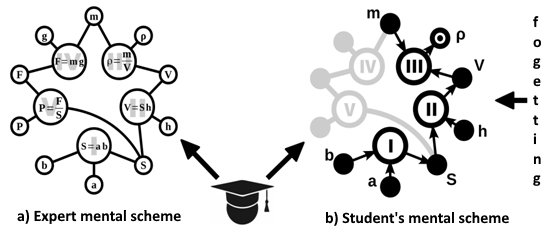
The importance of the process of formation and development of human mental schemes in learning implementation is described in the works of Barkhatova et al. ( 2017). Learning should first be based on sensory perception, and then move on to an abstract description: from action to concept. Such an approach will ensure the gradual formation of the informational and intellectual potential of the individual, based on sound knowledge, and developed thinking of the student.
The need to build training tools that take into account the peculiarities of the process of perceiving and remembering information by a person is noted by Shatalov ( 1987), and Ediges and Ediges ( 2004). Shatalov ( 1987) claims that in the process of mastering educational material, “reference signals” play an important role, which are convoluted model images of information in the form of visual and “sensual” graphic diagrams and drawings. The Ediges have developed a unique method of translating complex text into clear logical-graphic diagram. Such schemes make it possible not only to easily perceive even complex educational material, but also to remember effectively.
Thus, the current conditions for the growth of the information amount and the abundance of various educational electronic resources necessitate the structuring of educational material, and the psychological characteristics of generation Z in the perception of information and its assimilation require new forms of representing knowledge in a visually understandable form. To visualize the success of independent work on mastering the course, it is necessary to develop an inverted map of knowledge in the form of a mental diagram, where the tops of the map should answer questions of the practical application of the obtained unit of information. Studying and receiving an answer to the questions posed and completing control tasks is accompanied by shading, for example, in grey colour of the corresponding elements in the general scheme, for each topic, for each section, which visually determines the proportion of the material studied.
Findings
Consider the implementation of the proposed model on the example of the topic "Number systems". A fragmented inverted map of knowledge is presented in Figure
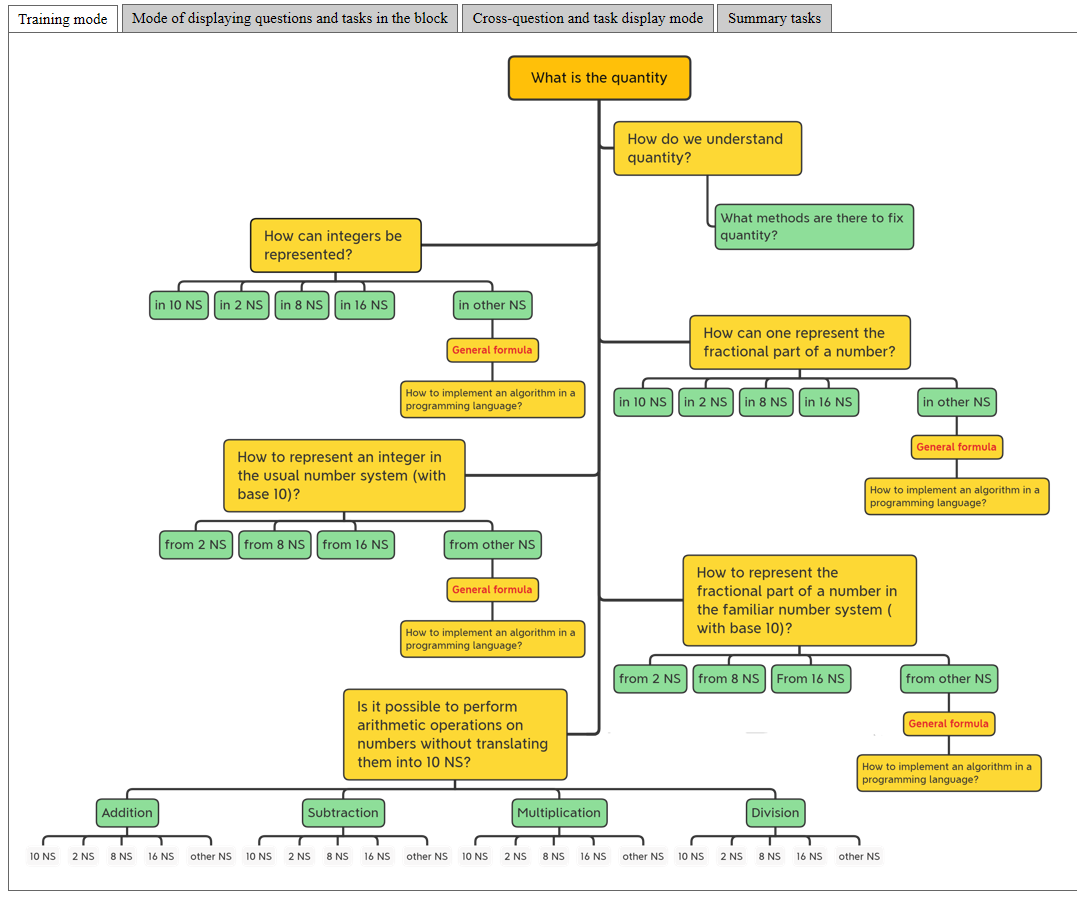
The textbook, built on the basis of a topological question-task tree of knowledge, has four modes. In all modes, the student can reveal the contents of the blocks.
In the training mode, passing to each node, visualized theoretical material is opened in front of the trainees, containing algorithms and examples (Figure
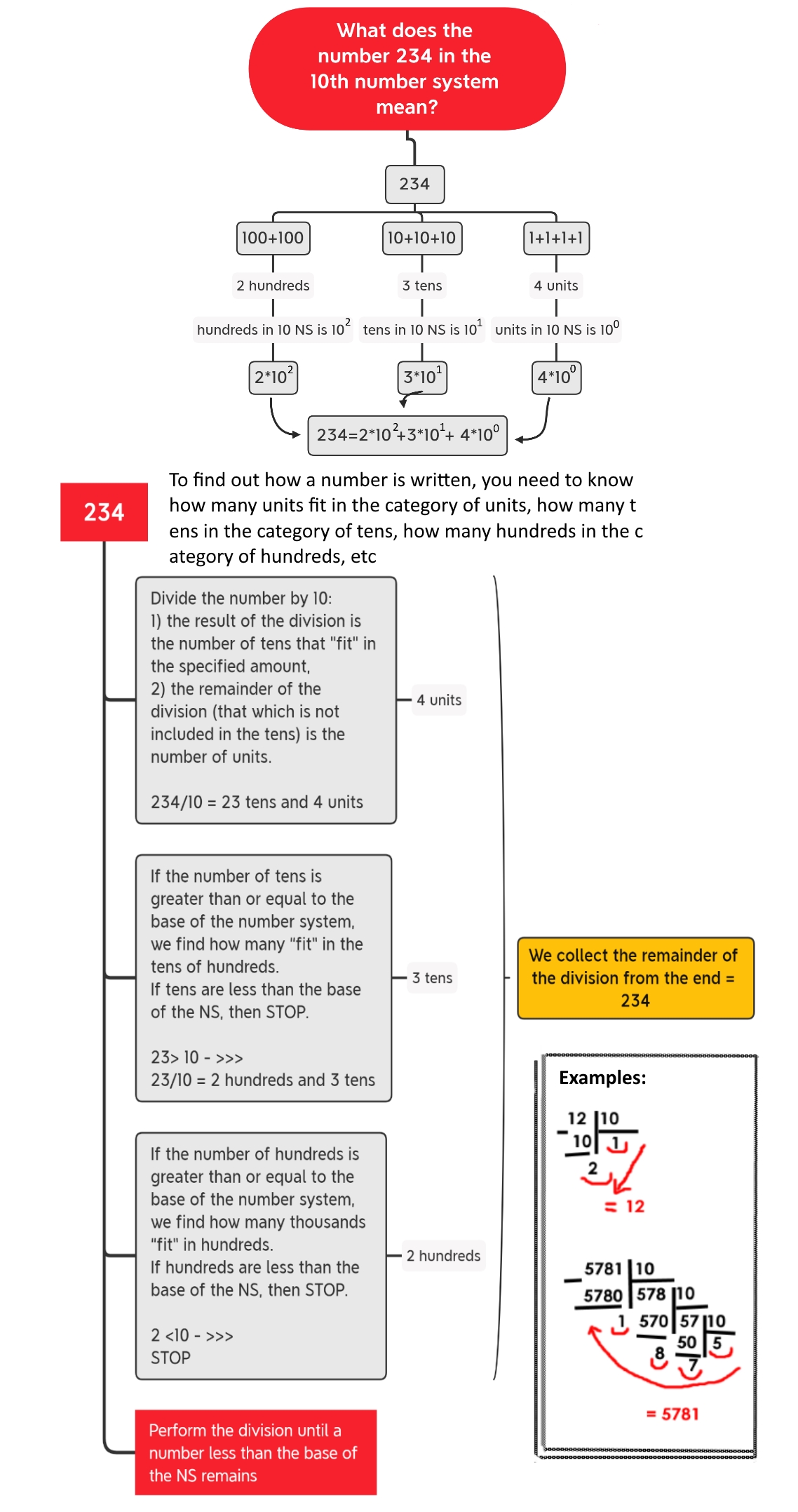
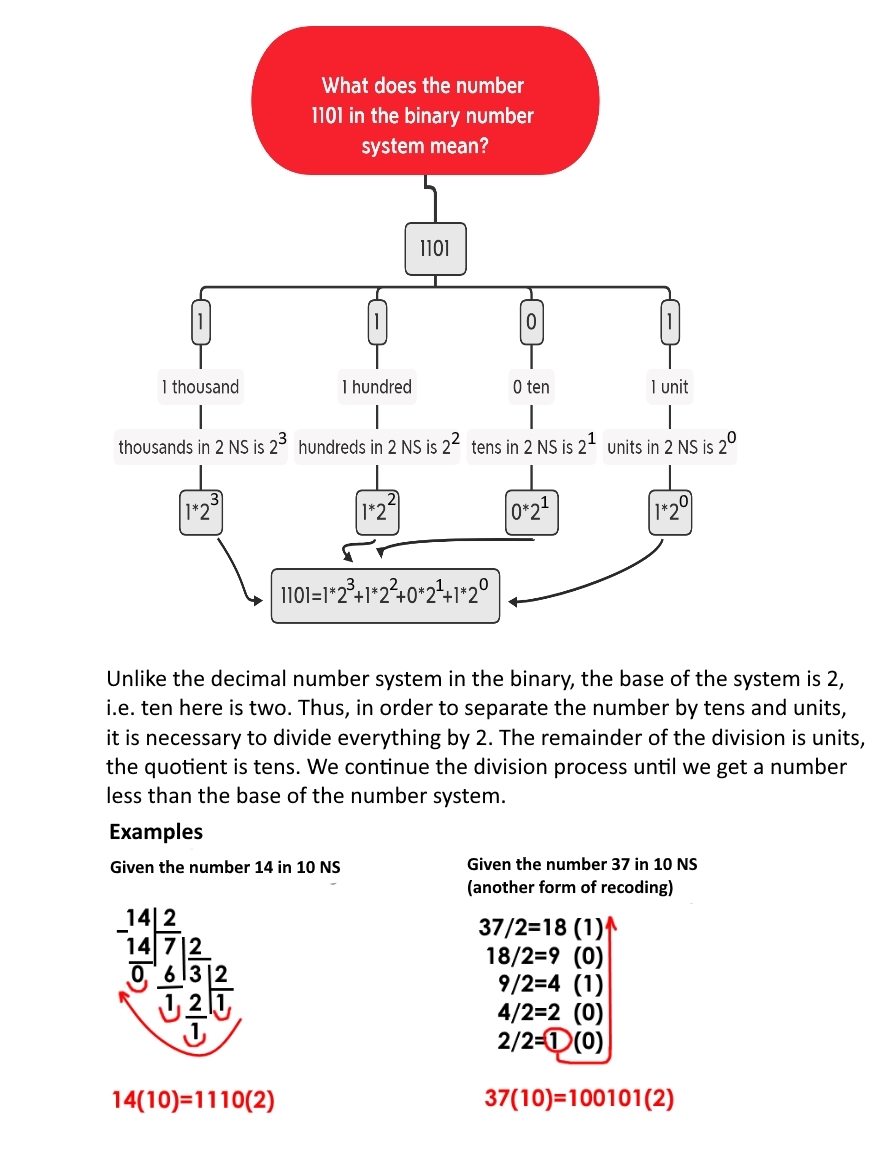
After the block is studied, it is highlighted in grey, and opens access to question-task modes, where tasks that control the quality of acquired knowledge are opened.
In the mode of displaying questions and tasks in a branch, a student can open tasks for the studied (grey) blocks (Figure
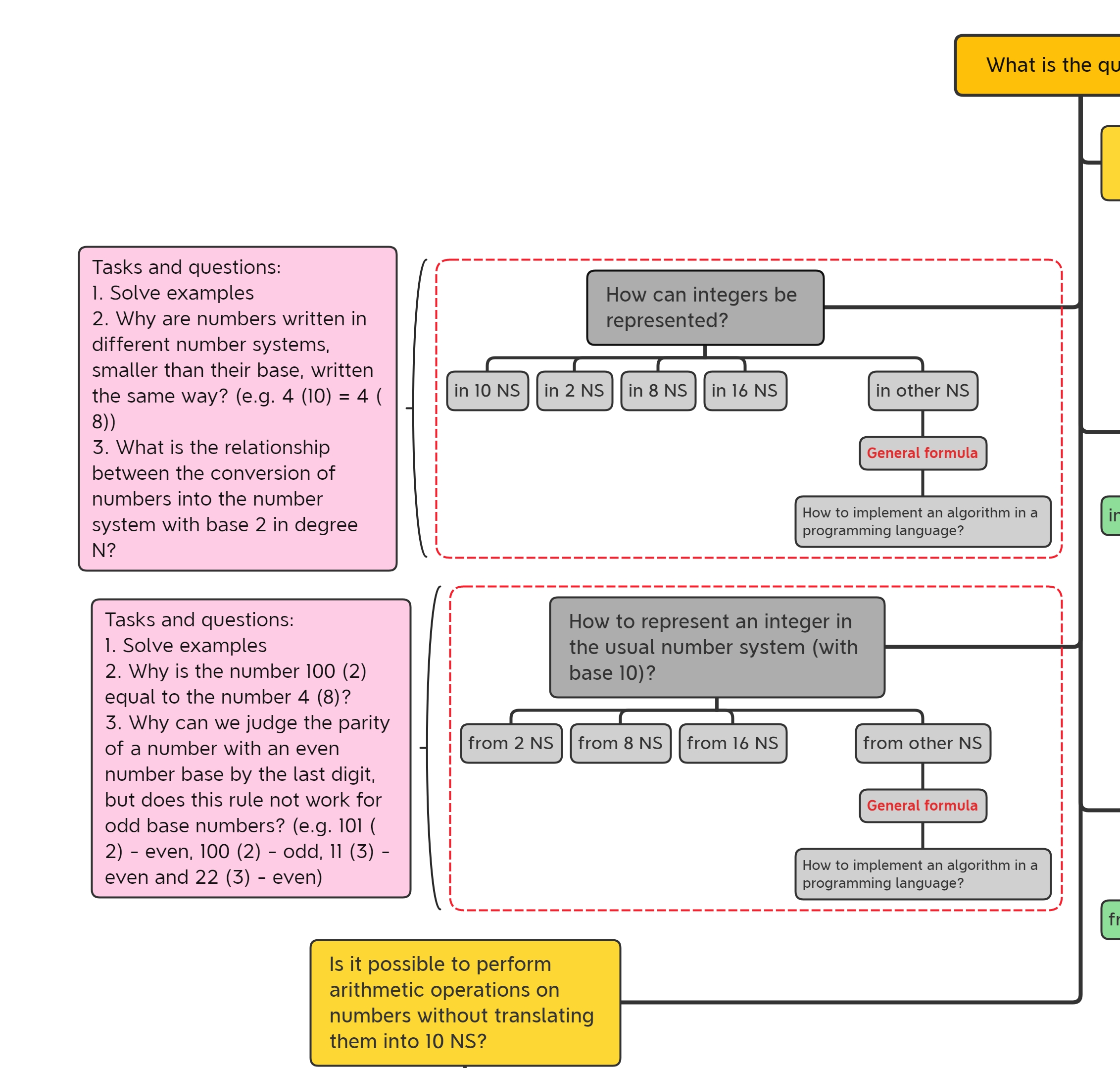
In addition to questions and tasks related only to specific subtopics, there are questions on understanding the connections between the blocks. Such questions can be answered in the mode of cross-cutting tasks and questions (Figure
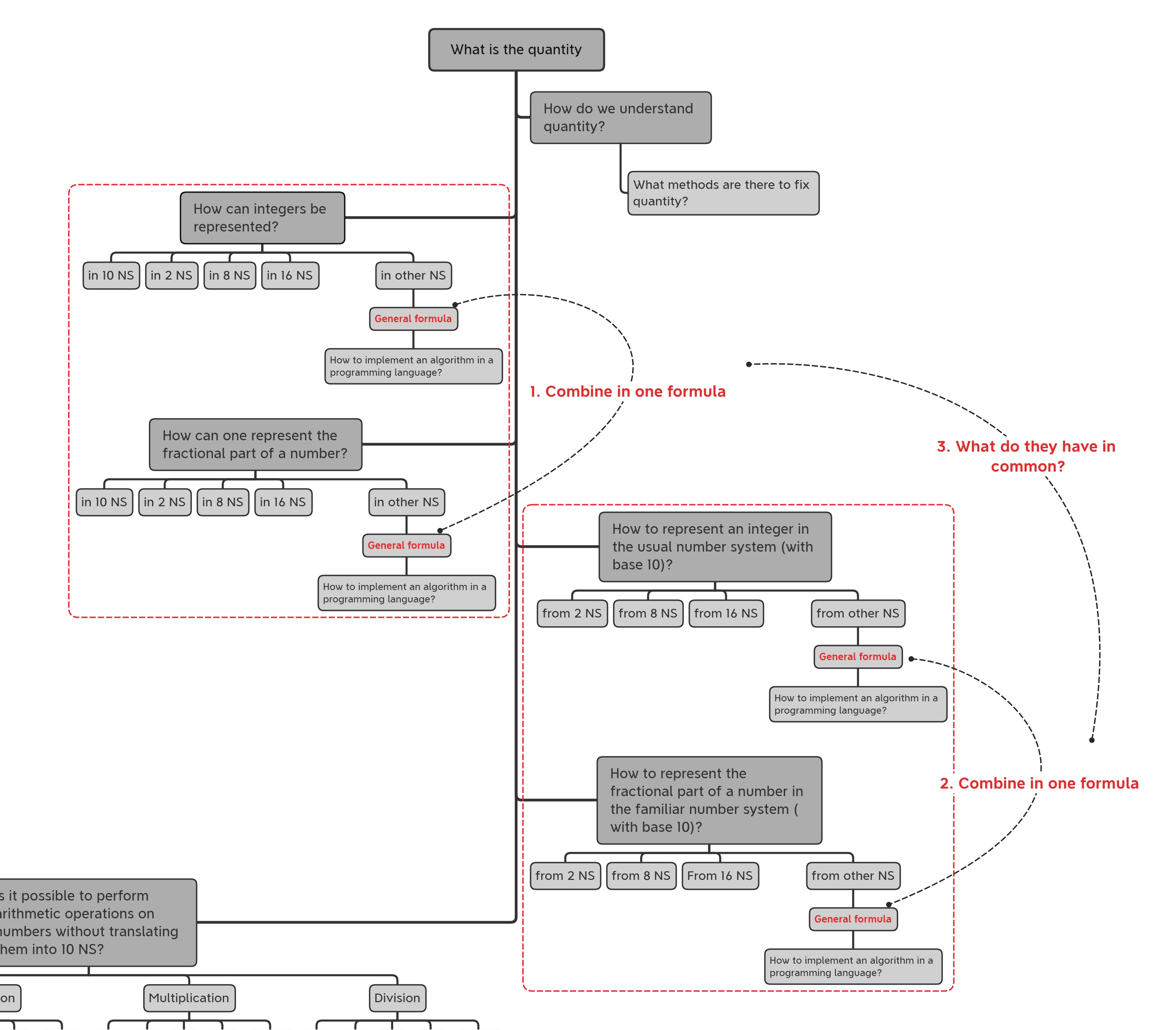
The final task on the topic "Number systems" is presented in Figure
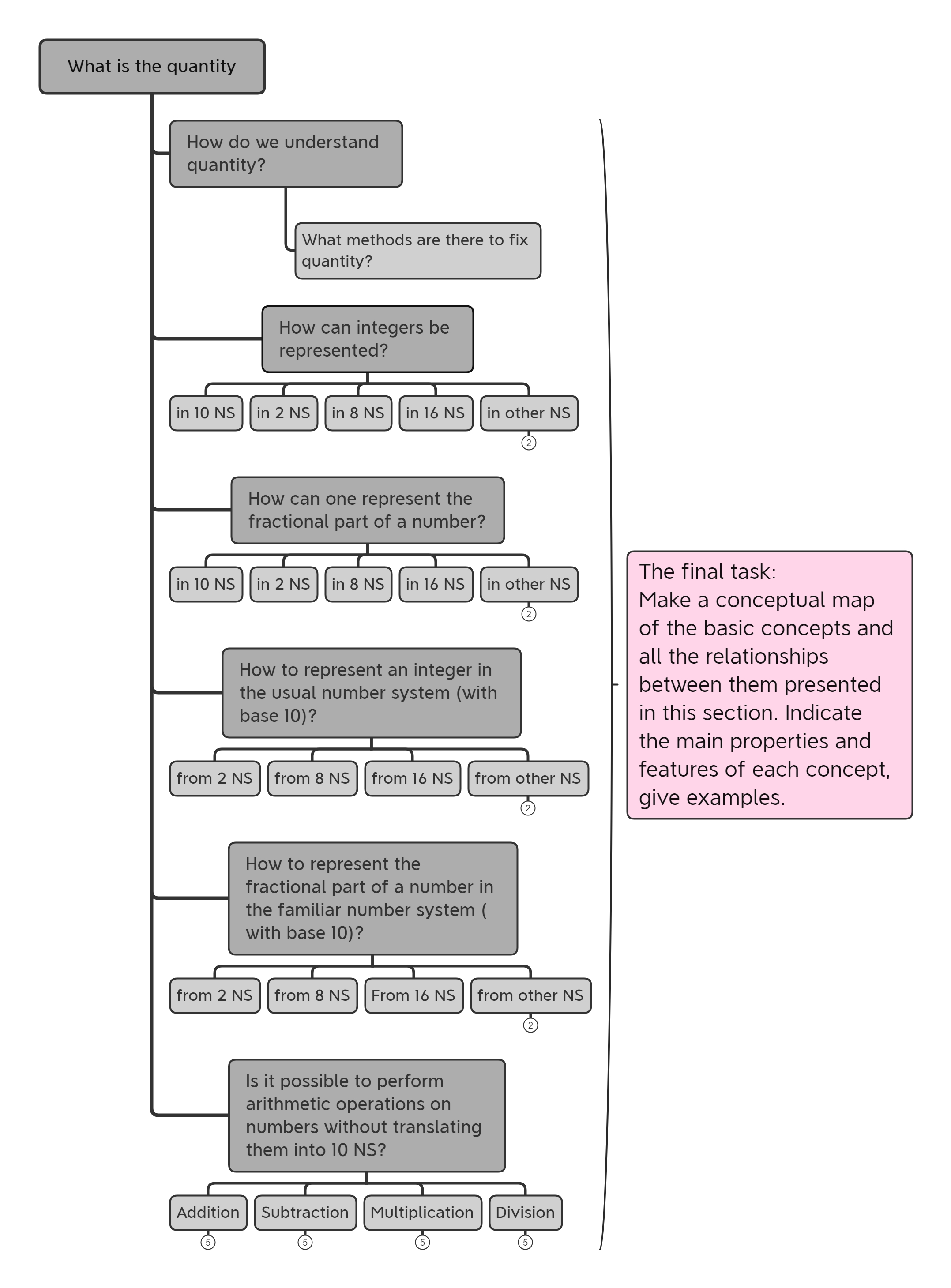
Thus, the construction of e-learning on the basis of a topological question-task knowledge tree allows, on the one hand, to meet the requirements for the perception of educational material of the modern generation (generation Z), and on the other, to visualize the self-learning process of students: study of educational material, degree of completion of tasks, and formed scheme of concepts in the memory of students.
Conclusion
Improving the quality of self-control and self-government by a student of his education becomes truly relevant in the modern realities and challenges of society. The current generation, possessing clip way of thinking, skilfully mastering gadget technologies, needs new self-educational tools and methods of e-learning and control. The effectiveness of their use depends on how they meet their needs, claims and whims. Given the abundance of electronic learning resources and the need for self-education, it is extremely important to create highly effective mechanisms for self-management and self-monitoring of student learning. The model of an electronic educational resource proposed in the work based on a topological question-task knowledge tree can largely eliminate the deficits of the DER that are adequate to the characteristics of generation Z. The question-task knowledge tree makes it possible to present educational material inverted, from questions to answers. Topological hypertext technology provides a visualization of the process of studying educational material, can display a search for the answer to a selected question, assimilation, and self-control of assimilation of knowledge. It provides the student with non-linear “self-management” by the sequence of studying the course, thereby simulating the productive stage of training - the period of preparation for the exam, as well as self-monitoring the level of knowledge of the course and “seeing” the success and effectiveness of training.
In Hattie ( 2008), the student’s self-control efficiency coefficient for his / her education was calculated, effect size (d)> 0.7, which turned out to be much higher than the acceptable 0.2. Thus, it should be concluded that the proposed method of visualized self-management and self-control of the educational process will significantly increase the effectiveness of self-educational activities of students.
Currently, software developers (by order of the authors) are developing a tool environment in the form of a cloud application that allows you to create inverted electronic resources based on a topological question-task knowledge tree. The authors are sure that the proposed method of visualized self-control of the educational process will significantly increase the effectiveness of the student’s self-educational activity, and the question-task format of inverted electronic resources will provide students with high motivation for the effectiveness of self-learning.
Acknowledgments
The study was supported by the Krasnoyarsk Regional Science Fund in the framework of the project: “An innovative program for preparing teachers for professional activities in a digital school based on a projective-recursive approach”, as well as the Ministry of Education and Science of the Republic of Kazakhstan under grant No. AP05133502 “Educational cluster platform“ Mega-class ” in teacher training in the context of the globalization of education” and the program and target project of the Abai Kazakh National Pedagogical University "Development of a system for preparing teachers for teaching and educating schoolchildren in a digitalized society".
References
- Asaulenko, E. V. (2018). Modelilirovanie mental’nykh skhem umeniya reshat’ vychislitel’nye zadachi na primere fizicheskikh zadach [Modelling mental circuits of the ability to solve computational problems using physical problems as an example]. In P. S. Lomasko (Ed.), III All-Russian Conference with International Participation on Actual Problems of Informatics and Information Technology in Education (pp. 15-19). KSPU. [in Rus.]
- Bazhenova, I. V., Babich, N., & Pak, N. I. (2016). Ot proektivno-rekursivnoy tekhnologii obucheniya k mental’noy didaktike [From projective-recursive teaching technology to mental didactics]. Siberian federal university. [in Rus.]
- Barkhatova, D. A., Nigmatulina, E. A., & Stepanova T. A. (2017). Social informatics: natural tools for students' information training in the conditions of embodied and mental approaches being employed. Journal of Social Studies Education Research, 8(2), 100-116.
- Doroshenko, E. G., Ivkina, L. M., Pak, N. I., Khegay, L., & Yakovleva T. A. (2020). Designing Methodological System of Teachers` Personalized Training for Networking Activities. International Journal of Applied Exercise Physiology, 9(2), 38-46.
- Ediges, A. P., & Ediges, E. (2004). Labirinty myshleniya, ili Uchyonymi ne rozhdautsya [Labyrinths of thinking, or Scientists are not born]. AST-Press book. [in Rus.]
- Hattie, J. (2008). Visible Learning: A Synthesis of Over 800 Meta-Analyses Relating to Achievement. Routledge.
- Novak, J. D., & Cañas, A. J. (2006). The theory underlying concept maps and how to construct and use them institute for human and machine cognition. http://cmap.ihmc.us/docs/theory-of-concept-maps.php
- Novak, J. D. (1993). Human constructivism: A unification of psychological and epistemological phenomena in meaning making. International Journal of Personal Construct Psychology, 6, 167-193.
- Novak, J. D. (1998). Learning, creating, and using knowledge: Concept maps as facilitative tools in schools and corporations. Lawrence Erlbaum Associates.
- Pak, N. I., Potupchik, E. G., & Khegai, L. B. (2020a). Kontseptsiya transformatsionnykh I perevyornutykh elektronnykh uchebnikov [The concept of transformational and inverted electronic textbooks]. RUDN Journal of Informatization in Education, Series “Informatization of Education”, 17(2). [in Rus.]
- Pak, N. I., Asaulenko, E. V., Grinberg, G. M., Myagkova, E. G., & Khegay, L. (2020b). Digital Environment of the Department as a Factor of Future Specialists` Professional Information Culture Formation. International Journal of Applied Exercise Physiology, 9(2), 164-173
- Pak, N. I., & Asaulenko, E. V. (2018). Avtomatizatsiya protsessa obucheniya resheniyu vychislitel’nykh zadach s pozitsiy kognitivnogo podkhoda [Automation of the learning process for solving computational problems from the position of a cognitive approach]. Informatization of education and e-learning methodology. The Proceedings of the II International Scientific Conference, 227-231. [in Rus.]
- Petrova, I. A. (2018). Metodika razvitiya poznavatel’noy samostoyatel’nosti studentov tekhnicheskogo vuza pri obuchenii informatike [Methodology for the development of cognitive independence of students at a technical university in teaching computer science]. Siberian federal university. [in Rus.]
- Raputo, A. G. (2010). Primenenie kontseptual’nykh diagramm, kontsept kart, kart uma I vizual’nykh metaphor dlya vizualizatsii pedagogicheskikh ob”ektov [Application of conceptual diagrams, concept maps, mind maps and visual metaphors for visualizing pedagogical objects]. http://econf.rae.ru/article/5471
- Shatalov, V. F. (1987). Tochka opory: Ob eksperimental’noy metodike prepodavaniya [Fulcrum: On the experimental teaching methodology]. Pedagogy. [in Rus.]
Copyright information

This work is licensed under a Creative Commons Attribution-NonCommercial-NoDerivatives 4.0 International License.
About this article
Publication Date
21 October 2020
Article Doi
eBook ISBN
978-1-80296-089-1
Publisher
European Publisher
Volume
90
Print ISBN (optional)
-
Edition Number
1st Edition
Pages
1-1677
Subjects
Economics, social trends, sustainability, modern society, behavioural sciences, education
Cite this article as:
Barkhatova, D. A., Balykbaev, T. O., Pak, N. I., & Khegay, L. B. (2020). A Student’s E-Learning Self-Control Method Based On A Topological Knowledge Tree. In I. V. Kovalev, A. A. Voroshilova, G. Herwig, U. Umbetov, A. S. Budagov, & Y. Y. Bocharova (Eds.), Economic and Social Trends for Sustainability of Modern Society (ICEST 2020), vol 90. European Proceedings of Social and Behavioural Sciences (pp. 1039-1050). European Publisher. https://doi.org/10.15405/epsbs.2020.10.03.120

